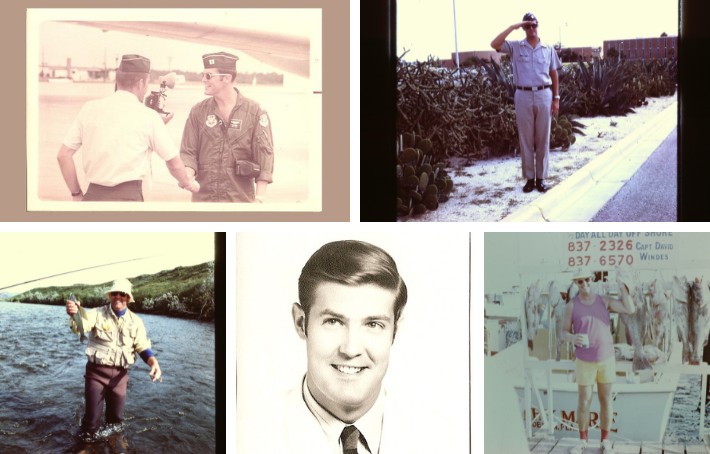A Journey of Introspection and Waiting: Part 1
Stephanie Ayars’ life and her father’s were forever changed by hereditary amyloidosis. Here, in the first of a two-part post, she shares their stories:

I’d like you to meet my dad, Paul. I’m sharing some photos taken over the decades, all of which I love because they showcase times when my dad was healthy—at least on appearances. Little did we know that amyloidosis was wreaking havoc in his body.
But back to Paul so that you can get a quick glimpse of him as a person versus a disease…
My dad was born in New Jersey in 1945… he had a relatively “normal” American upbringing with boy scouts, No. 2 pencils, Coca-Cola in glass bottles, and an early dream to become an eye doctor. He was always a great student and so after college, medical school, and serving in the U.S. Air Force, he accomplished that dream and went into private ophthalmology practice in south Texas.
Academically and professionally speaking, my father was brilliant and very accomplished. But he was more than his career. He was a husband, a son, a brother, and a father. He loved adventure and travel—with some of his favorite places being Columbia and Peru. A sun-seeker, one of his favorite past-times was fishing with his friends or baiting hooks with live bait for his three squeamish daughters!
There is so much more I could share about my dad and I miss him very much, but I could not be prouder of him because the journey of amyloidosis was his greatest act of courage, faith, strength, and resilience.
The first time I heard the word “amyloidosis” was on a trip to Texas with my sisters for Thanksgiving in 2008.
At this point, my dad had divorced and re-married—still living in Corpus Christi and still practicing ophthalmology.
It was over dinner when my sisters and I were introduced to FAMILIAL AMYLOIDOSIS (“AMY” from this point forward). A typical family Thanksgiving meal, dinner conversation started with updates on lives that were spread out across different states, on funny stories from our childhood… until things got serious.

While not an ideal time to break the news that one is now facing a rare and very serious diagnosis, I suppose there really is no “good timing” on such a situation. The conversation from that point was sobering and somber—all cloaked with a veil of hope and reassurance by my dad.
It’s important to note that things didn’t go from healthy to AMY overnight. To back up about 12-16 months, my dad had been having some health issues. He and his wife were many months prior when my dad was really struggling on a hike. At the time, he attributed it to the altitude and perhaps a few too many pints of mint chocolate chip ice cream. (Is it possible to inherit a gene for the love of mint chocolate chip ice cream?!)
A cardiac workup revealed he had cardiomyopathy. (Editor’s note: Cardiomyopathy is a progressive heart muscle disease in which the heart is abnormally enlarged, thickened, or stiffened.) Fortunately, his cardiologist was very attentive and intuitive and suspected there was something more at play with my dad’s condition, but wasn’t able to further diagnose.
And so from there, my dad was on a quest for answers—a quest that involved several trips to various medical centers, precious time passing, anxiety levels peaking, and frustrations mounting among all of us.
Eventually my dad ended up at Mayo Clinic in Rochester, Minnesota where he was able to get the final diagnosis of hATTR amyloidosis—also known as Hereditary or Familial AMY. Finally, pieces fell into place. As the news sank in, my dad was finally able to understand more about how his father died—thus, the genetic link. Up until then, my dad just knew that his dad died of cardiomyopathy at the age of 61.
Welcome to the family, AMY. (If only I was referring to a real person. Humor—with a touch of sarcasm—continues to get me through a lot of the more challenging moments in life.)
From this point, it seems like we were all swept away in a swiftly moving current of AMY. I say “we” because of emotions—but the real impact was on my dad and his wife.
Basically, the headline from the team at Mayo Clinic read something like this:
You Need a Combination Heart & Liver Transplant—and You Need It Now
So, after 31 years in medical practice, my dad took a few months to wrap it up and retire. He hadn’t planned on retiring yet, so that alone was a massive life transition that I know was difficult for him to process. Instead of a retirement party, there were small dinners with close friends where the conversation was about educating others on AMY and saying what might be final good-byes as they pack up their life to move to Minnesota to WAIT for a CHANCE of a combination transplant.
As we waited, I turned to the internet. I needed information, data, numbers, statistical odds—anything that would bring me comfort in a situation where I felt completely helpless. I spent hours at night after work reading about AMY… because there was so much that I didn’t understand about medicine, about genetics, about the human body.
What I found the most staggering was the harsh reality in the number of people who were waiting for an organ transplant in the U.S. In fact, according to the data from May 2021, “17 people die each day waiting for an organ transplant.”
My dad was incredibly special to me and those who loved him, but he just became a number. A number in a very long line of other numbers.
And so, for months I just hoped and had to have faith in a stranger… someone who might be a match.
Finally, on October 22, 2009 my dad was given the gift of life, a day that I refer to as my dad’s second birthday.
I remember exactly where I was when I got the call—I was on a business trip to Colorado, out to dinner with colleagues, and my phone rang—it was my sister. I knew the only reason she would call me on a work trip was if there was news—good or bad. In this case, GOOD. My dad was in recovery after transplant surgery.
We didn’t talk long because we didn’t have much information—and we knew it would be a long road ahead. But did this mean the end of AMY?! Could it be that my dad somehow “beat” AMY?!
I returned to the table in tears excited to share the news. My boss ordered champagne and we made a toast to my dad.
My tears fell also for the family that I knew was grieving a loss. So as much as October 22, 2009 was a celebration of my dad, it was also a celebration to honor a stranger who so generously gave my family the greatest gift possible.

Over the next few weeks and months, my dad and I did talk about my sisters and I getting tested for the hATTR AMY gene.
Truthfully, I didn’t think about it much, really. It seemed like the practical thing to do, so I jumped right in and coordinated to have my blood draw locally and they could send it to Mayo Clinic where the test would actually be performed.
I honestly didn’t think it through much—I didn’t really know that I needed to do so. My personality is such that information is empowerment, so I didn’t even hesitate to get tested. But, in retrospect, I now realize that there were a lot of things to consider beyond just the results.
From a practical side, I didn’t think about health insurance and what impact—if any—test results might have on my coverage. But more importantly, I didn’t think through the emotional side of the gene test. An optimist, I suppose I should have better prepared myself for both possible outcomes. I don’t know if I was just grasping for good news, or if I was protecting myself by thinking only about a negative test outcome—or perhaps both.
I was 32 years old at the time and had a nice job with decent health insurance. I do recall it was an uphill battle once I got the bill because AMY wasn’t listed as a diagnosis with the insurance company, so I begrudgingly did end up paying out of pocket for the test.
I somewhat nonchalantly went through the motions… I knew there was a risk of the test being positive, but “I’m sure it will be negative.”
In part 2 of this two part-post, Stephanie shares her experience getting her genetic testing results—and the events that transpired thereafter.
- Categories
- Lastest Posts
- Phase 3 Clinical Trial of Birtamimab in AL Amyloidosis Fails to Meet Primary Endpoint
- FDA Approves Amvuttra™ (vutrisiran) for ATTR-CM: More Options for Patients
- FDA Approves Attruby™ (acoramidis) for the Treatment of ATTR-CM: A New Option for Patients
- ARC Launches Clinical Fellowship Program to Advance Amyloidosis Care



